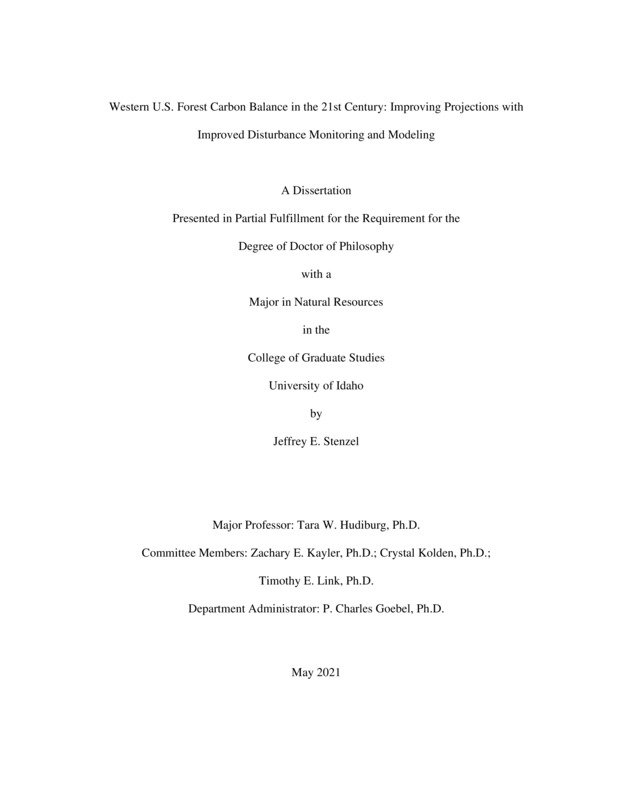Western U.S. Forest Carbon Balance in the 21st Century: Improving Projections with Improved Disturbance Monitoring and Modeling
Stenzel, Jeffrey. (2021-05). Western U.S. Forest Carbon Balance in the 21st Century: Improving Projections with Improved Disturbance Monitoring and Modeling. Theses and Dissertations Collection, University of Idaho Library Digital Collections. https://www.lib.uidaho.edu/digital/etd/items/stenzel_idaho_0089e_12121.html
- Title:
- Western U.S. Forest Carbon Balance in the 21st Century: Improving Projections with Improved Disturbance Monitoring and Modeling
- Author:
- Stenzel, Jeffrey
- ORCID:
- 0000-0001-8881-0566
- Date:
- 2021-05
- Program:
- Natural Resources
- Subject Category:
- Ecology
- Abstract:
-
The forests of the western United States face profound impacts from shifts in climate, natural disturbance regimes, and land management in the 21st century. Under novel conditions, forest ecosystem services will be altered, including impacts to forest climate moderation, resource provision, and biodiversity. However, the complex processes that determine present-day observed forest structure and composition across the complex terrain of the region are incompletely understood. As a result, scientists and land managers are confronted with considerable uncertainty as to how widespread natural and human impacts upon forests will result in changed processes and states. This dissertation employs model-observation frameworks to examine and improve upon the understanding of how disturbance will impact western U.S. forest carbon balances from site to regional scales. Chapter 1 addresses deficiencies in current process model representations of direct emissions and ecosystem mortality transfers during forest fire. In this study, I incorporate novel observations and modify an ecosystem biogeochemical model to compare to model default assumptions. Projected carbon balance impacts of observation-based vs model-based assumption are then quantified in: 1) A carbon dense forest via a modified Daycent biogeochemical model; 2) Across the western United States from 2000-2016. At the state level, model default assumptions lead to 50-110% overestimates in carbon emissions, primarily due to the unrealistic combustion of live tree bole biomass and compounded by a lack of standing-dead biomass pool representation. Projections demonstrate that emissions overestimates can increase to 300-500% in carbon dense forests (e.g. old growth) in the midterm (30 years) due to altered decomposition. Chapter 2 quantifies the carbon and water balance impacts of an experimental selective thinning in a ponderosa pine forest in the University of Idaho Experimental Forest. I use automated and traditional ecosystem stock and flux measurements to estimate the impacts of treatments from 2016-2019 at contrasting tree and stand scales, with a focus on the balance between primary producer density reductions and mitigated summer drought stress. I then project the on and off-site carbon balance impacts of treatment through 2050 with a life cycle assessment (LCA) and with the Daycent biogeochemical model. Projections allow the exploration of whether carbon parity with control stands is reached within common emissions reduction time periods. Observations indicated an average 30% increase in thinned stand residual tree growth. In contrast to the control stand, treated stand tree transpiration persisted through the summer drought period. However, production and water use increases did not compensate for tree density reductions and both yearly Net Primary Production (NPP) and transpiration decreased in treatment stands. Projections demonstrated that large harvest-event emissions pulses from long-lived woody biomass pools led to long carbon deficit legacies; treatment carbon storage parity with control stands was not reached by 2050. Chapter 3 employs a dynamic global vegetation model (DGVM) to simulate chapter 2 stand dynamics and examine model applicability for simulations across a northern Rocky Mountain ecoregion domain. The FATES DGVM simulates forest composition and structure, disturbance regimes, biogeochemistry, and biophysics, operating within the Community Land Model 5 (CLM5) of the Community Earth Systems Model (CESM). I examine FATES dynamics in the context of: 1) Variable intensity selective harvests; 2) Historical and future control and treatment stands; and, 3) sensitive input parameter variation.
- Description:
- doctoral, Ph.D., Natural Resources -- University of Idaho - College of Graduate Studies, 2021-05
- Major Professor:
- Hudiburg, Tara W
- Committee:
- Kayler, Zachary E; Kolden, Crystal ; Link, Timothy E
- Defense Date:
- 2021-05
- Identifier:
- Stenzel_idaho_0089E_12121
- Type:
- Text
- Format Original:
- Format:
- application/pdf
- Rights:
- In Copyright - Educational Use Permitted. For more information, please contact University of Idaho Library Special Collections and Archives Department at libspec@uidaho.edu.
- Standardized Rights:
- http://rightsstatements.org/vocab/InC-EDU/1.0/

